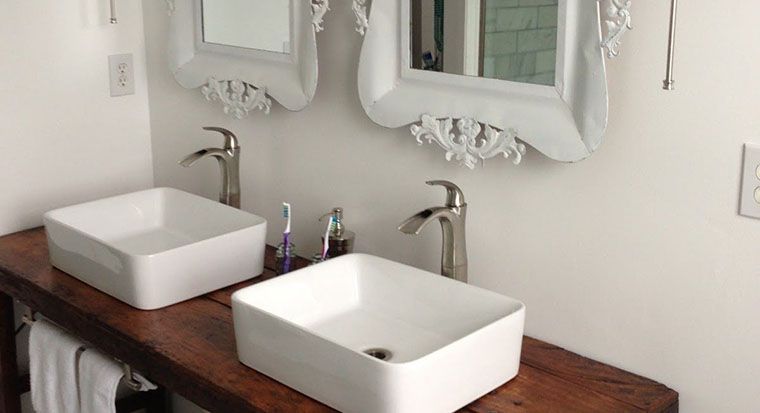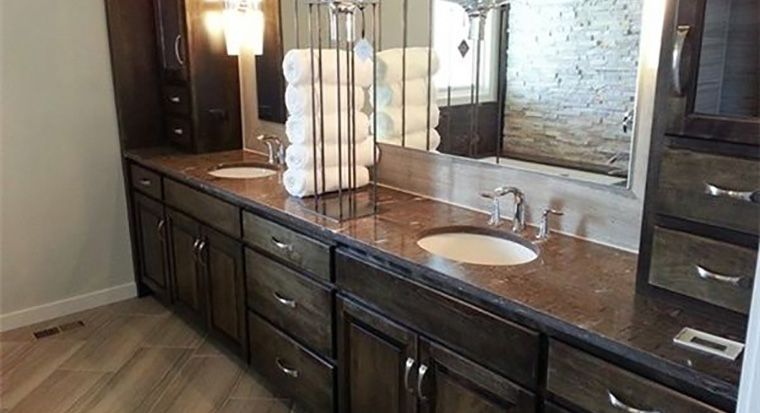Bathroom vanities are very useful features that do not always get the attention it deserves. Many bathrooms do not even have them because of space constraints. However, if you are planning on bathroom remodeling, you should seriously consider putting one in, even if it means knocking down a wall. Bathroom vanities can provide much-needed storage and work space, so it is well worth the trouble.
Table of Contents
ToggleIf you do plan to put in a vanity, or if you already have one, then you should definitely choose the vanity top carefully. You want one that will be beautiful as well as durable, and your best choices would be granite, marble, or quartz stone. Whichever one you choose, your next decision would be the edge profile. These are important for design as well as function because it can show off the beauty of the granite, marble, or quartz stone you choose and keep your bathroom safe, especially if you have small children.
You need to decide on the type of edge when finalizing your bathroom remodeling design, especially if you choose quartz stone. This is because edge treatments for quartz stone are included in the manufacture and not put in during fabrication. Some edge profiles may also not be available with quartz stone, so this will have an impact on your final design. Here are some basic edge profiles you might want to consider for your granite, marble, or quartz vanity tops.
Square edge vanity
One of the most basic and simplest edge types you can choose for your bathroom vanity is the square edge. The edges are flat and with seemingly straight lines. Upon closer inspection, however, the edges are not actually sharp, as this could lead to nasty cuts and injuries, especially to the heads and faces of small children.
Fabricators make minuscule cuts, known as kerfs, on the edges of the stone to make it smooth rather than sharp. These cuts are not obvious, but they keep the stone edges safe for anyone who uses the bathroom. The kerfs also make the edges less likely to develop cracks and chips.
The simplicity and clean lines of the square edge make it very versatile, so they fit perfectly well with any bathroom style. However, it is a particularly great choice if you want to give your vanity tops a low profile. This is indicated when you have highly decorative details to which you want to draw attention, such as an ultra-nice faucet or awesome mirror.
If you want something a little softer than the basic square edge, you can choose an eased edge. For this, the fabricator will make the kerfs a little deeper, giving the edge a pronounced roundedness on the top edge while maintaining a flat face.
Beveled edge vanity
Another basic edge treatment is the beveled edge profile, usually recommended for traditional bathroom styles. The angled cut is typical of the classical architectural style and gives the bathroom an elegant touch. As with the square edge, fabricators put in kerfs along sharp edges to soften them and make them safer for small children.
The original purpose of the beveled edge is to show the world that the vanity tops were made of real stone, and not just a surface treatment. The angled cut provided a cross-section of the stone, so there was no way to hide if it was not granite or marble all the way through. This was at a time when only the rich could afford granite and marble in their homes, so it was a status symbol. Today, of course, this is no longer the case, but the beveled edge profile is still popular.
The standard single beveled edge vanity involves an edge profile with a cut of 45 degrees along the top edge, then changing to a flat front. The bevel or chamfer can be more than 45 degrees, in which case it is an extreme bevel treatment. If the cut of over 45 degrees is on the bottom edge, this is a reverse extreme bevel. Another variation is the double bevel, where the cut is on the top and bottom edges. It is also possible to use a bevel edge in combination with other edge treatments for a more complex vanity edge.
Mitered
A mitered edge profile is primarily a treatment to make a vanity top look thicker than it is. Most stone slabs are no more than 3 cm (1-3/16 inches) thick because of two things: cost and weight. A thicker slab would obviously be more expensive, but more importantly, it would be heavier than you would want. However, you can create the illusion of a thicker slab using the mitered edge treatment.
Basically, a mitered edge involves gluing a piece of the same stone as the countertop to the edge at a 90-degree angle. This is the false edge of the countertop, making it seem that the edge is the width of the glued piece. In most cases, the fabricator will cut the vanity edge and the separate piece at a 45-degree angle so they fit perfectly. This might seem like a simple matter, but it takes a high level of skill and experience to produce a mitered vanity edge without making it obvious.
Variations on the mitered edge are the eased mitered edge and the waterfall edge. The eased mitered edge is the same as the standard one, except that the top “edge” is rounded. The waterfall is the same as the standard mitered edge except that the glued piece goes all the way to the floor.
Bullnose vanity edge
Finally, there is the bullnose vanity edge. Quite popular with homeowners, it is most likely you have seen this edge type before. The bullnose edge is completely rounded on top and bottom, giving the vanity top a smooth and elegant look. You should definitely consider this if you have small children, and if you have a contemporary bathroom design.
You can choose a standard bullnose or go for one of two variations: the demi-bullnose and the half-bullnose. These are very similar in appearance, with a rounded top and angled bottom edge. The only difference is the half-bullnose has a softer bottom edge than a demi-bullnose does.
Conclusion
These are just the most basic edge profiles that your remodeling company may offer for free as part of a special package. Other edge treatments are also available, although some of the more complex ones may mean extra charges as these are much more difficult to fabricate.
Whatever vanity edge type you choose, you want to make sure your remodeling company can carry it out correctly. A badly made edge can ruin the look and function of your bathroom vanity. Cabinet Land Kitchen and Beyond is a local remodeling company specializing in quality cabinets and countertops, including bathroom vanity tops.
We have a showroom located in Schaumburg, Illinois, and work only with experienced fabricators for your vanity top edges. We offer better free consultation services and quotes, so you know exactly what to expect from your purchase.
Also, we carry top cabinet brands at the best prices compared to our competitors, such as Advance Cabinets and Handsome Cabinets. We service Chicago land and have the expertise and resources to complete virtually any type of kitchen cabinets – ON TIME and ON BUDGET with top-quality craftsmanship that will exceed your expectations.
Visit us today to see what we have to offer!







